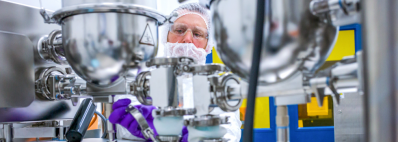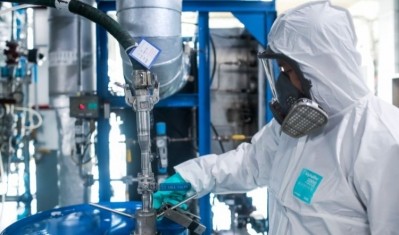Promotional Features
Insights into creating an inhaler product through jet milling
Chronic respiratory disease is on the rise worldwide.
Between 1990 and 2017, there was a 39.8% rise in the incidence of such conditions across the globe, with the highest prevalence in high-income countries.1 Lower respiratory infections are the most deadly communicable disease, and are ranked as the fourth leading causes of death globally.2
For drug developers, this means there is a pressing need to develop new and more effective treatments for respiratory diseases. Inhalation drug delivery is a common means of treating such diseases, with the ability to deliver topically or systematically acting drugs. The advantage of this type of therapy is being able to deliver effective therapies at lower doses, potentially reducing systemic side-effects and avoiding first pass metabolism, as well as allowing for some drugs to have a rapid onset of action.
At present, this means that many treatments for asthma and chronic obstructive pulmonary disease (COPD) are treated through inhaled therapies. Wider than this, people living with cystic fibrosis also receive their therapies in this way, and there is the possibility to treat system diseases, such as type-2 diabetes, through inhaled insulin. Due to the COVID-19 pandemic, there has also been a burst of research into the potential for inhaled vaccines, as this would allow them to be delivered globally without the logistical challenges associated with cold-chain delivery.3
For drugmakers themselves, a significant barrier to a successful inhaled therapy product arrives during development, where decisions must be made on the correct approach, such as whether to utilize a carrier-based or carrier-free approach. This is where the expertise of a contract development and manufacturing organization (CDMO) partner can be invaluable.
Carrier-free and carrier-based
For asthma and COPD, as well as other respiratory conditions, the most common treatment approach is with dry powder inhalers (DPIs). This involves the drug product being delivered by the inhaler through a reservoir or as a capsule, which is actuated by the patient through inhalation. There are different techniques to the formulation of such therapies, but the most common two are carrier-free, mainly produced by spray drying, and carried-based approach, which can utilize jet milling, among other processes.
Spray drying is able to provide precise control over particle size distribution of between 1-5µm, allowing for the delivery of particles deep into the lung. The carrier-based approach also comprises active pharmaceutical ingredient (API) down to 1-5µm, but unlike the carrier-free formulation, these are blended with carrier materials which assist on their transportation and delivery to the deep lung, while ensuring a stable product.
Both have their particular use cases, with the carrier-based approach being a more established process and is relatively simple to carry out with an experienced partner. This method does not require any solvents and the blending process is well-understood. For treatments that only require a small amount of API, the carrier-based approach is ideal to create a stable formulation. However, if there are any special requirements, such as if there is a product that is sensitive to stress, then it could be better suited to a spray-drying process.
The jet milling process
Jet milling is a micronization process that works by exposing crystalline particles to high pressure, which mechanically reduces the material into smaller particles (1-5µm) and increases their surface area. This process involves a milling chamber and high pressure nozzles, usually using nitrogen, which together creates a vortex motion. Once the API is introduced, the vortex causes the particles to accelerate and then to break up due to friction with the chamber walls and other particles.
This latter point confers a significant advantage because it means the process does not require additional material to break up the API, instead the particles themselves are the grinding media. The output of particles is decided by a static classification ‘pipe’, which is engineered prior to the beginning of the process through tweaking the geometrical characteristics of the pipe. When combining these factors, the defining characteristics of jet milling as a micronization process are particle on particle collisions, a static classifier, no mechanical moving parts, and a high throughput.
The process parameters involved are two factors: the feeding rate and the grinding pressure. Particle size can be modified by acting on both or one of these parameters. In addition, the geometrical parameters can also be modified to change the particle size distribution. This can be altered by changing the diameter of the feeding nozzle and the grinding nozzles, and also adding or subtracting from the number of grinding nozzles.
When jet milling is suitable
The jet milling process is suitable for products that do not tend to degradate when introduced to stress, and where there is an initial crystalline material that is stable, which would not generate a lot of amorphous material. The process is high throughput, making it efficient for large-scale manufacture, and the absence of mechanical grinding elements minimizes any potential deterioration of equipment. The process also does not require any solvents or hazardous material. Alongside other factors, this makes the process suitable for most small molecules.
As with any process, there are certain limitations that have to be considered. Careful evaluation of the process is required to understand whether any solid state changes could occur, such as polymorphism and polymorphic displacement. Evaluation of the morphology and size of the particle must also be considered, as the aerodynamic diameter determines where inhaled therapies will be deposited within the respiratory tract.
Quality by design
When working with an experienced partner, the considerations previously mentioned will be part of the quality by design (QbD) approach for scaling up and validating the manufacturing process. This process will be influenced by the needs of the drug developers and the goals they have for the micronization campaign.
At Lonza Small Molecules, this involves a step-by-step approach that begins with a feasibility study to understand how the particle is breaking up, and what type of energy is required to make this happen. A risk assessment will also be conducted to understand all possible critical process parameters. The first trials will work to understand how the pressure and the feed rate impact the micronization of the particle. From this point, and with the knowledge gained from the first step, there will be a design of experiments whereby an interval of pressure and feed rate are set, and a proven acceptable range is created.
On scaling up the process, to ensure that it is within specification, an in silico study will be carried out with additional variability, such as taking into account pressure and feed rate variability, and model error. This provides confidence that when the process is scaled up, there is a high degree of certainty that results will be within specification.
Once scaled up, and understanding the conditions for the system, engineering batches are carried out to see if there is variability in the process. Finally, the process undergoes validation, ensuring that the end product meets the quality, safety, and efficacy standards established during its development.
Selecting the right partner
For drug developers, partnering with a CDMO on jet milling should not just be based on the experience with this process; there needs to be wider knowledge of inhalation drug delivery. That is why Lonza established a Center of Excellence for Dry Powder Inhaler drug product development in 2020. From this center, the company is able to offer a service of head-to-head evaluation of particle engineering approaches, along with capsule-based DPI formulation design and development. Expertise in the entire inhalation drug development process gives a top-down perspective that can help navigate potential setbacks before they occur.
Other factors to consider are how deep the expertise into jet milling and the mechanical process itself extend. At Lonza Small Molecules, there is an engineering team that focuses solely on optimizing the equipment involved in the process. If there is a challenging product – one that is very cohesive, for example – the engineering team makes it possible to design a different type of chamber for use in the jet milling process that can navigate this, improving yield and particle size control.
The combination of broad and specific knowledge is one of the major benefits delivered by partnering with a global CDMO. Leveraging the knowledge that comes with this kind of network can make a big difference for drug developers, smoothing the drug development process to ensure inhalation drug products can reach patients as efficiently and safely as possible.
References
1. GBD Chronic Respiratory Disease Collaborators. (2020). Prevalence and attributable health burden of chronic respiratory diseases, 1990-2017: a systematic analysis for the Global Burden of Disease Study 2017. The Lancet. Respiratory medicine. 8(6), 585–596.
2. World Health Organization. The top 10 causes of death.
3. Heida, R.; Hinrichs, W. L.; Frijlink, H. W. (2022). Inhaled vaccine delivery in the combat against respiratory viruses: a 2021 overview of recent developments and implications for COVID-19. Expert review of vaccines. 21(7), 957–974.







